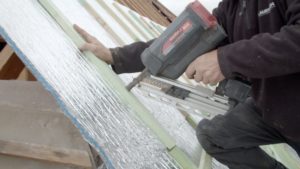How Multi-Layer Insulation Improves Energy Efficiency

Energy efficiency has become a top priority for anyone looking to lower operating costs and reduce environmental impact, and insulation plays a key role in achieving this goal. One of the most effective solutions has become multi-layer insulation. This advanced insulation technology provides enhanced thermal resistance, reduces heat transfer, and minimizes energy loss.
Whether you’re designing a commercial warehouse, retrofitting a metal building, or upgrading a residential property, multi-layer insulation can significantly improve energy efficiency while offering additional benefits like moisture control and durability.
What Is Multi-Layer Insulation?
Multi-layer insulation (MLI) is a system that combines multiple layers of reflective, thermal, and sometimes vapor-resistant materials to reduce heat transfer. Unlike traditional insulation, which relies on a single material to resist heat flow, MLI uses layers to address various types of heat transfer.
Each layer serves a specific purpose:
- Reflective Layers: These reflect radiant heat away from the building, preventing excessive heat gain.
- Thermal Barriers: High R-value materials within the layers resist conductive heat flow, maintaining stable indoor temperatures.
- Vapor Barriers: Some MLI systems include vapor barriers to prevent moisture infiltration, reducing condensation and protecting structural components.
By combining these features, multi-layer insulation offers superior energy performance compared to single-material solutions.
How Multi-Layer Insulation Works
Multi-layer insulation improves energy efficiency by targeting all three modes of heat transfer:
Conductive Heat Transfer
Conductive heat transfer happens when heat moves through solid materials like walls, roofs, or floors. Multi-layer insulation uses thermal barriers like rigid foam or fiberglass to resist this type of heat flow, keeping indoor temperatures stable.
Convective Heat Transfer
Convective heat occurs when air movement carries heat through gaps or cracks in the building envelope. MLI minimizes convective heat transfer by creating airtight layers, sealing gaps, and preventing drafts.
Radiant Heat Transfer
Radiant heat transfer is the most significant factor in energy loss for buildings exposed to sunlight. Reflective layers within MLI reflect radiant heat away from the structure, reducing the workload on HVAC systems.
By addressing all three heat transfer mechanisms, multi-layer insulation provides comprehensive thermal protection, ensuring energy efficiency in a variety of building types and climates.
Benefits of Multi-Layer Insulation for Energy Efficiency
Superior Thermal Resistance
Multi-layer insulation has higher R-values compared to single-layer systems. The combination of thermal barriers and reflective surfaces prevents heat from escaping in winter and entering in summer, creating a more consistent indoor environment. Less reliance on heating and cooling systems can yield significant energy savings.
Radiant Heat Control
Reflective layers are particularly effective in managing radiant heat, which accounts for a large portion of energy loss in metal buildings and attics. Since it can reflect up to 97% of radiant heat, multi-layer insulation minimizes temperature fluctuations and reduces HVAC load.
Moisture Control
Many multi-layer insulation systems, such as Quattro’s reflective vapor barrier insulation, include vapor barriers to block moisture from entering the building envelope. This prevents condensation, mold growth, and water damage, further enhancing the insulation’s long-term performance.
Reduced Costs
With improved thermal resistance and radiant heat control, HVAC systems don’t have to work as hard to maintain comfortable temperatures. This not only lowers energy bills but also extends the lifespan of HVAC equipment by reducing wear and tear.
Durability
The multiple layers in MLI provide added durability, protecting the insulation from damage caused by moisture, pests, or wear over time. This makes it a cost-effective choice for long-term energy efficiency.
Why Quattro’s Multi-Layer Insulation Stands Out
Quattro’s multi-layer insulation combines cutting-edge reflective technology with vapor barrier protection and high thermal resistance, making it a top choice for improving energy efficiency. Here’s what sets Quattro apart:
- Dual Functionality: Quattro’s insulation reflects radiant heat while preventing moisture buildup, offering a complete solution for thermal and moisture management.
- Ease of Installation: Lightweight and flexible, Quattro’s insulation is easy to install in a variety of applications, from walls and ceilings to attics and roofs.
- Long-Term Use: Because it was made for commercial and industrial use, Quattro’s insulation withstands the wear and tear of demanding environments.
Contact us today to learn more about how Quattro’s multi-layer insulation can transform your next project and improve your building’s energy efficiency!


